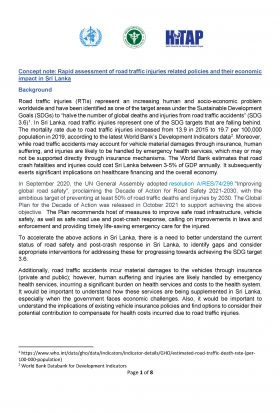This website uses cookies so that we can provide you with the best user experience possible. Cookie information is stored in your browser and performs functions such as recognising you when you return to our website and helping our team to understand which sections of the website you find most interesting and useful.
Rapid assessment of road traffic accidents related policies and their economic impact in Sri Lanka
Project Code
66221010HM021F0
Research team
Researchers
Co - Researcher
Project Details
Start: 10 October 2023
End: 31 December 2023
Project Status
Conducting Research - 45%
Viewer: 567
Publish date10 November 2023 01:33
Project Summary
Road traffic accidents (RTAs) represent an increasing human and socio-economic problem worldwide and have been identified as one of the target areas under the Sustainable Development Goals (SDGs) to “halve the number of global deaths and injuries from road traffic accidents” (SDG 3.6). In Sri Lanka, road traffic injuries represent one of the SDG targets that are falling behind. Moreover, while road traffic accidents may account for vehicle material damages through insurance, human suffering and injuries are likely to be handled by emergency health services, which may or may not be supported directly through insurance mechanisms. The World Bank estimates that road crash fatalities and injuries could cost Sri Lanka 3-5% of GDP annually. It subsequently exerts significant pressure on healthcare financing and the overall economy.
To accelerate the actions to prevent road traffic accidents and deaths in Sri Lanka, there is a need to better understand the current status of road safety and post-crash response in the country, to identify gaps, and consider appropriate interventions for addressing these for progressing towards achieving the SDG target 3.6.
Regarding this, Health Intervention and Technology Assessment Programme (HITAP) under Ministry of Public Health Thailand, in collaboration with World Health Organisation in Sri Lanka, is conducting ‘a rapid assessment of the road traffic accidents in Sri Lanka’ intending to understand the determinants and recent trends in road traffic accidents in Sri Lanka, vehicle insurance regulations and policies on casualty care and emergency service provision-related reimbursements as well as share Thailand and other countries experiences in improving service delivery to post-trauma care and lessons/best practices for Sri Lanka.







 Concept note: Rapid assessment of road traffic injuries related policies and their economic impact in Sri Lanka
Concept note: Rapid assessment of road traffic injuries related policies and their economic impact in Sri Lanka
